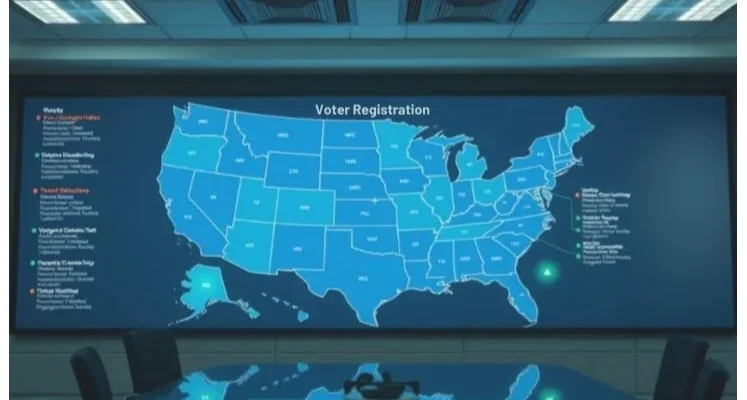Did you know that New Jersey recently removed more than 1 million bogus registered voters from its voter rolls—almost one in five registrations across the state? This historic cleanup has put a national spotlight on the importance of accurate voter registration and the challenge of securing free and fair elections in modern America. This article dives deep into the factors that prompted New Jersey’s sweeping action and uncovers what it means for voting rights, public trust, and the future of democracy statewide and nationwide.
Startling Facts About New Jersey Voter Roll Cleanup
The reality facing New Jersey’s voting infrastructure was both urgent and unprecedented. With over 1 million ineligible or inaccurate voter registrations cluttering the statewide voter registration system, election officials were forced to take decisive action. According to the Public Interest Legal Foundation, these numbers reflect years of data lapses, outdated list maintenance, and competing interests around voter access versus fraud prevention.

This massive cleanup operation was not merely about state pride or governmental housekeeping. It’s a story with deep roots in legal mandates, the winds of federal law—including past actions under both the Trump administration and the Biden-era US Department of Justice—and a critical urgency to protect both voting rights and public faith in the electoral system. Election officials—backed by state law, executive orders, and collaboration with federal agencies—undertook a months-long effort, examining the registration system with painstaking detail to ensure only eligible voters remain on the rolls.
"New Jersey’s removal of 1 million bogus registered voters underscores a crucial inflection point for America’s democracy."
What You'll Learn About New Jersey's Voter Registrations
Why accurate voter registration matters for democracy
The challenges facing election officials in New Jersey
How executive orders and law enforcement intersect with voting rights
Key takeaways from the voter roll purge
Context: How Did New Jersey's Voter Registration Rolls Become Problematic?
The journey toward this drastic purge began decades ago. While voter registration is the key to voting rights, the process has always struggled to keep pace with population shifts, outdated state law, and changing technology. Registration systems across the state—and the nation—were designed for paper-and-pencil era data, not today’s fast-paced, digital world. As people move, pass away, or change their eligibility, the voter lists can fill with outdated or duplicate entries if list maintenance is too slow or enforcement lapses.

Historical Trends of Voter Registrations in New Jersey
Through much of the 20th and early 21st centuries, New Jersey’s voter registration system relied heavily on local offices and manual updates. As the statewide voter registration database grew, so did opportunities for outdated records—including those for deceased voters or individuals who had moved out of state. The 2002 Help America Vote Act mandated statewide voter lists, but discrepancies, clerical errors, and system lags persisted.
In recent years, a growing chorus—from the bipartisan secretaries of state to the Public Interest Legal Foundation—highlighted alarming mismatches between eligible voters and names still on the voter roll. Such trends fueled controversy, raising rampant speculation about voter fraud, but also worries about disenfranchisement if cleanups go too far.
Factors Contributing to Bogus Registered Voters
Several factors caused New Jersey’s voter rolls to balloon with bogus registrations. Delayed state law reforms meant that people who moved or died sometimes remained on the lists for years. Election officials faced legal and political pushback whenever they tried to proactively purge voter rolls, with some advocacy groups warning of possible violations of voting rights. Meanwhile, overburdened local offices—tasked with enforcing registration system changes, often as part of special task forces—struggled to synchronize data with federal agencies like the Social Security Administration or state departments updating death records.
Technological upgrades sometimes lagged funding, making real-time verification and removal difficult. Additionally, the conflicting pressures between federal law requirements and interest legal foundation lawsuits made the environment for election officials even more complex. Thus, the backlog continued to grow until the state reached a tipping point, making a bold overhaul unavoidable.
The Process: How Did Election Officials Identify 1 Million Bogus Registered Voters?
Identifying so many ineligible or duplicate registrations required a herculean push involving both technology and teamwork. New Jersey’s election officials—led by the secretary of state, supported by local clerks and the statewide voter registration system—undertook exhaustive reviews, cross-referencing multiple government databases. This wasn’t just software working alone: dedicated task forces involving data analysts, IT professionals, and law enforcement all played active roles in scrubbing each questionable entry.

Role of Election Official Teams and Task Force Operations
Election official teams served as the backbone of the cleanup operation. Utilizing new digital registration system upgrades, these groups ran thousands of data-matching algorithms, flagged suspicious patterns across the statewide voter registration records, and cross-checked death and relocation notices with state and federal law enforcement alerts. Task force members manually reviewed ambiguous or edge-case entries, reaching out to municipal clerks for verification whenever automated rules produced uncertain results.
The impact of well-organized task force operations was pivotal: by bringing together diverse skills and resources, they navigated obstacles such as incomplete voter information, technological inconsistencies across counties, and legal challenges from advocacy and interest legal foundations. The effort demonstrated how collaboration and perseverance at every level of government could solve what once seemed like an insurmountable administrative problem.
Collaboration with Federal Agencies and Law Enforcement
In this high-stakes environment, New Jersey’s election officials did not work in isolation. The clean-up mobilized coordination involving federal agencies like the Department of Homeland Security and the U.S. Postal Service, whose change-of-address data proved invaluable. Law enforcement agencies and the state attorney general’s office lent guidance, especially in preventing potential voter fraud or identity theft. Through executive orders, the governor empowered officials to share data securely while safeguarding personal records.
Effective collaboration created safety nets that balanced voter rights with the mandates of federal law. The oversight of the attorney general and routine audits from bipartisan election commissions helped ensure accountability and transparency, crucial for maintaining public interest and legal confidence throughout the process.
Implications: Why New Jersey Had to Remove 1 Million Bogus Registered Voters
The consequences of this massive registry overhaul ripple across New Jersey’s democracy and beyond. By clearing out ineligible or duplicate voter registrations, state election officials aimed to restore faith in the voting process and preempt false claims about rampant fraud. Ensuring that only eligible voters appear on the rolls is a direct defense of the integrity of every future election in the state.

Impact on Voting Rights and Public Trust
Some worry that voter roll purges could inadvertently jeopardize voting rights, particularly for marginalized groups. But according to New Jersey’s election officials, every possible safeguard was in place to prevent accidental disenfranchisement. The state prioritized transparency by sending notice letters and appeals options to those flagged for removal. Election officials argue that such comprehensive approaches increase public trust, as accurate rolls ensure no legitimate vote is diluted by an ineligible registration.
Restoring voter confidence is especially vital at a time when misinformation about the security of American elections is widespread. NJ’s robust communication campaigns and community partnerships aimed to assure citizens that the integrity measures did not target lawful voters, but rather sought to foster a system everyone could believe in.
Legal and Policy Impacts: Executive Orders and Election Rules
The legal and policy environment played a powerful role in driving the purge of bogus registrations. Under state law, the secretary of state had clear powers to update the statewide voter registry, but legislative backing and executive orders ensured those powers were used with the full weight of legal authority. The state’s attorney general and other top officials issued detailed guidance on compliance with both state and federal laws, echoing similar approaches under the Trump administration and refined in the Biden era.
Together, these executive orders and evolving election rules signaled to every level of government—and the watching public—that voter registration maintenance was a top civic priority. The process also paved the way for future reforms that promise to keep voter rolls current while meeting the highest standards of fairness and accuracy.
Comparative Perspective: How Do Other States Manage Voter Registration Rolls?
New Jersey’s purge was historic, but not unique. Other states—including Texas, Ohio, and Florida—have confronted similar problems, albeit with varying strategies and degrees of public controversy. Some have established permanent, bipartisan commissions; others rely heavily on technology or cross-check programs with federal agencies. Learning from these comparisons is vital for updating our own systems and maintaining nationwide confidence in elections.
Voter Roll Cleanup Comparison by State |
||
State |
Number of Bogus Registrations Removed |
Year of Largest Purge |
|---|---|---|
New Jersey |
1,000,000+ |
2024 |
Ohio |
465,000 |
2019 |
Texas |
190,000 |
2020 |
Florida |
80,000 |
2012 |

Lessons From the Trump Administration’s Approach to Voter Roll Maintenance
The Trump administration put a sharp national focus on voter list maintenance and alleged voter fraud, leading to new federal law guidance and an uptick in lawsuits by interest legal foundations. However, critics warned that aggressive purges under the guise of voter integrity risked disenfranchising legitimate, mostly minority voters. The New Jersey experience, with its painstaking verification process and transparent appeals, offers a blueprint for preserving eligible voters’ rights while still protecting the system from abuse.
Future successful list maintenance efforts will require continued bipartisan oversight and unwavering public communication—lessons New Jersey has learned the hard way, but which now offer a model for states grappling with similar concerns.
Addressing Criticisms: Are Voter Roll Purges Suppressing Votes?
Controversy lingers around any large-scale voter roll update. Civil rights groups and legal advocates have argued that even the best-designed registration removals can mistakenly scrub eligible voters, especially those newly moved or who have complex documentation. But New Jersey’s task force worked under the strict scrutiny of state and federal oversight to put multiple safeguards in place.
Election Officials’ Safeguards Against Wrongful Removal
Election officials have put in place an array of checks—notice letters, appeals opportunities, and in-person help desks run by all levels of the state’s election teams. Systemic training for municipal staff, combined with regular audits by attorneys from both major political parties, aims to ensure that the public interest is always preserved—even if the process is not always perfect.

Despite some public skepticism, these layers of review and recourse demonstrate New Jersey’s commitment to protecting voting rights. As one election official commented:
"Maintaining clean voter rolls is not synonymous with disenfranchisement," comment New Jersey election officials.
Opinion: My Take on Why New Jersey Had to Remove 1 Million Bogus Registered Voters
The risks of inaction and public skepticism: When voter registration rolls become overgrown and inaccurate, every election is at risk of controversy—ranging from accusations of voter fraud to more general narratives eroding public trust. In today’s fast-changing political climate, that risk is simply too great to ignore.
The critical role of transparency in voter registration: This enormous purge has proven that transparency is a keystone for democracy. New Jersey’s open communications, fair hearing processes, and published legal guidance provided a template for how to do it right—and how to maintain legitimacy in the eyes of both voters and watchdogs.
Balancing fraud prevention and voting rights: Ultimately, the state’s challenge is a balancing act: to safeguard against fraud, while never losing sight of both the letter and the spirit of voting rights protections. This effort—grounded in law, aided by collaboration, and watched by both political parties—shows that it is possible to achieve both goals, even in an era of division and uncertainty.
The risks of inaction and public skepticism
The critical role of transparency in voter registration
Balancing fraud prevention and voting rights
People Also Ask: Why New Jersey Removed 1 Million Voters From Its Voter Roll
What caused the surge in bogus voter registrations in New Jersey?
A combination of outdated state law, insufficient list maintenance procedures, delays in death notifications, frequent changes in residency, and technology limitations led to a steady buildup of ineligible voter registrations. Over many years, these factors created a massive administrative backlog only a large-scale, coordinated task force effort could finally resolve.
Does the removal of registered voters affect election outcomes?
Removing ineligible or duplicate registrations helps protect the accuracy and fairness of the voting process by ensuring only valid, eligible voters can cast ballots. When done with transparency and due process, as in New Jersey, the effort does not disenfranchise legitimate voters and helps guard against claims of systemic voter fraud that could undermine public faith in election outcomes.
What steps do election officials take to ensure fair voter registration removal?
Election officials follow detailed legal procedures, including sending removal notifications, allowing appeals, and providing community outreach to help affected individuals re-register if needed. They use data matching tools to reduce the risk of human error, and regular audits keep the process accountable. This layered, transparent approach is designed to minimize mistakes while safeguarding everyone’s voting rights.

FAQs on Why New Jersey Had to Remove 1 Million Bogus Registered Voters
How are bogus voter registrations identified?
Election officials use data matching algorithms, cross-checks with death and relocation databases, and input from federal law enforcement to flag ineligible entries. These processes are regularly audited to ensure accuracy.What role do local election officials play in the removal?
Local officials are responsible for investigating ambiguous cases, coordinating with the secretary of state’s office, and reaching out to individuals when there’s uncertainty about eligibility. Their frontline expertise ensures purges are just and justified.Are there legal protections for wrongly purged voters?
Yes. Federal law requires options for appeals, while state-level executive orders mandate that voters must be allowed to contest wrongful removal and re-register immediately—even on Election Day in some cases.

Key Takeaways: New Jersey’s Voter Registration Overhaul
Voter registration cleanup is crucial for electoral integrity
Election officials deployed comprehensive strategies
Public trust requires ongoing vigilance
Conclusion: Safeguarding Democracy Through Clean Voter Rolls
New Jersey’s sweeping removal of 1 million bogus registered voters is a critical defense of democracy—proving that accuracy, transparency, and teamwork build the foundation for future fair elections.
Take Action: Stay Informed on Voter Registration Best Practices
Check your own voter registration status regularly, follow local election official updates, and support policies that protect both the integrity and the inclusivity of our voter rolls.
 Add Row
Add Row  Add
Add 




Write A Comment